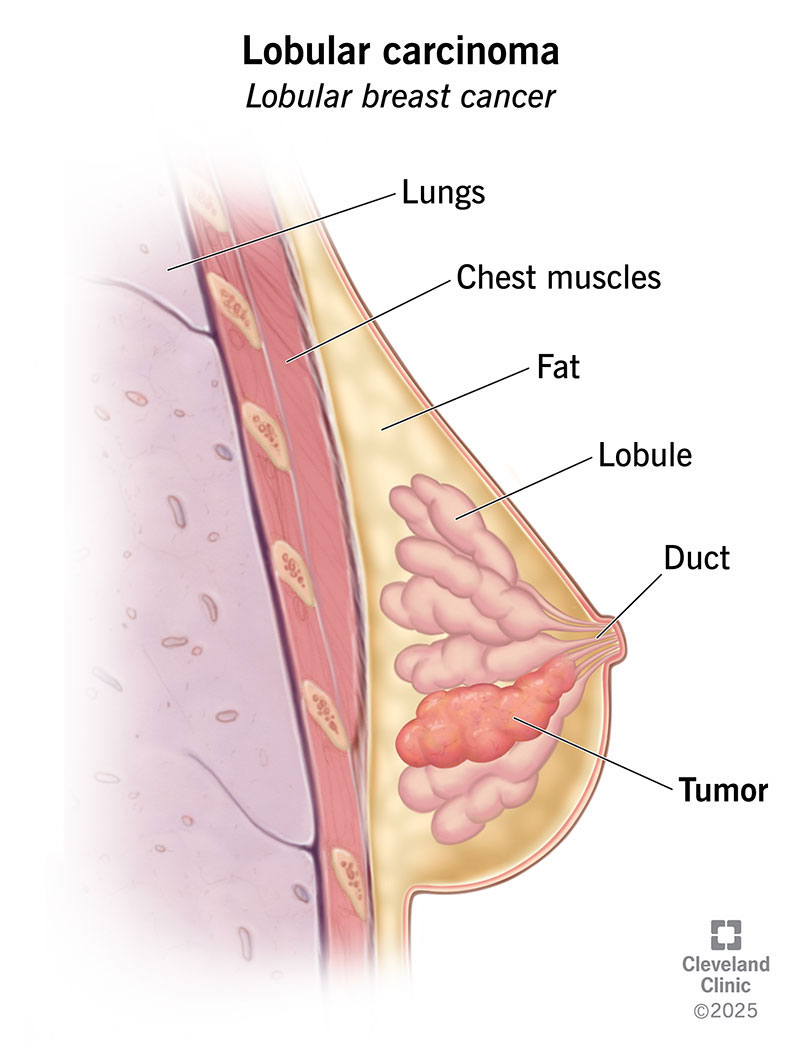Invasive lobular carcinoma (ILC) starts in the milk-producing glands in your breasts. It causes symptoms like breast pain, changes in your breast skin or discharge from your nipples. ILC can spread to many different areas of your body. Treatment may include surgery, along with chemotherapy and other anti-cancer drugs.
Advertisement
Cleveland Clinic is a non-profit academic medical center. Advertising on our site helps support our mission. We do not endorse non-Cleveland Clinic products or services. Policy

Invasive lobular carcinoma (ILC) is a type of breast cancer that starts in the milk-producing and transportation system of your breast. Healthcare providers may use the term “lobules” or “terminal duct lobular units” when they describe where this cancer starts.
Advertisement
Cleveland Clinic is a non-profit academic medical center. Advertising on our site helps support our mission. We do not endorse non-Cleveland Clinic products or services. Policy
About 10% to 15% of breast cancers are invasive lobular breast cancer. This type of breast cancer usually grows in response to estrogen, the main female hormone. It grows slowly. You may have ILC for years before it’s seen on a mammogram or causes symptoms. Like all other breast cancers, ILC can spread through breast tissue or to other areas of your body.
ILC affects an estimated 31,000 to 46,000 women in the U.S. each year. Early diagnosis and treatment may cure it. But ILC can spread to other areas of your body many years after your diagnosis and treatment.
Most of the time, breast cancer happens when cancer cells multiply to create a tumor. The tumor may make a lump in your breast that you can feel. ILC is different. Early on, ILC cells spread out in a single file to form strands or strings of cancer cells.
As ILC grows slowly and may not form a lump, it may not cause noticeable changes in your breasts. When it does, symptoms can include:
Advertisement
ILC happens when genetic mutations (changes) turn healthy cells into cancer cells. Experts aren’t sure what causes the mutations. Researchers believe the following factors increase your risk of having invasive lobular carcinoma:
ILC may cause two unusual complications:
Breast cancer that spreads (metastatic breast cancer) typically affects your brain, bones, liver and lungs. ILC may spread to those areas. But it may also spread to less common areas, including your:
A healthcare provider will ask about your symptoms. They’ll examine your breasts and the area near your armpits. They may do the following tests:
They may recommend a breast biopsy to get a small sample of your breast tissue. A medical pathologist will examine the tissue under a microscope. They’ll look for abnormal breast cells and other cancer signs.
Your cancer care team will use test results to stage the cancer and plan your treatment. There are four stages of invasive lobular carcinoma:
Advertisement
Your treatment may be a combination of:
Your recovery will depend on your treatment. For example, it can take two to four weeks to recover from breast cancer surgery. Recovering from treatments like chemotherapy may take six months to a year. It’s important to understand how cancer treatment may affect your daily routine. Don’t hesitate to ask your oncologists what to expect in terms of recovery.
Contact your cancer care team if you have:
Cancer survival rates are estimates of the percentage of people with a specific cancer diagnosis who are alive after a certain time — usually one to five years — after they receive a diagnosis.
Advertisement
Research shows that overall, 94% of women with ILC were alive and cancer-free five years after their diagnosis. That estimate includes women who have stage I to stage III when they’re diagnosed. In general, the earlier the stage at diagnosis, the better the prognosis. About 86% of women with ILC are alive and cancer-free 10 years after their diagnosis.
The five-year survival rates for ILC are similar to other types of breast cancer. But they’re 4% to 10% lower at that 10-year mark.
Healthcare providers are working to understand why this is and come up with treatment options to improve your chances of being cancer-free in the long run.
The rates don’t predict how long you’ll live with cancer. Survival rate information can be confusing and cause concern. If you have questions, your oncologist will explain what a survival rate means in your situation.
You know your breasts better than anyone. And you’re probably familiar with common breast cancer symptoms. Even so, you may wonder about a change in your breasts that you don’t associate with breast cancer. Invasive lobular carcinoma (ILC) doesn’t cause a lump in your breast like most other types of breast cancer. ILC symptoms may be breast pain or dimples in your breast skin.
Advertisement
Don’t hesitate to talk to a healthcare provider if your breasts look or feel different. They’ll listen to your concerns. And if invasive lobular carcinoma is the cause, your provider will be there to answer questions and support you through treatment and beyond.
A lobular breast cancer diagnosis can be scary. At Cleveland Clinic, we offer expert diagnosis and personalized treatment for lobular breast cancer.

Last reviewed on 04/21/2025.
Learn more about the Health Library and our editorial process.